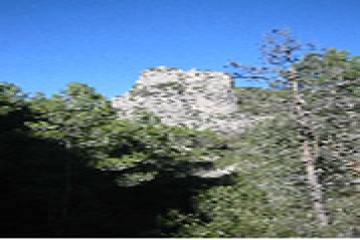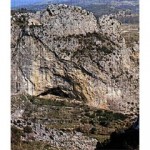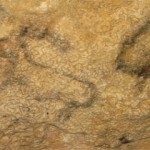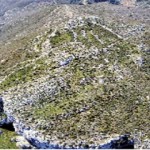History
1. PREHISTORY
Some author has pointed out: ‘We are convinced that the ethnic roots of the Valencian lands are in the Alcalà Valley, particularly in the area between the Barranquet of Beniaia, the Barranc de les Ronches, the Solana de la Cairola and the Planet of the Condoig ‘.
In fact, in the Barranquet of Beniaia there is a deposit of stone tools, with an abundance of ‘chopers’ (useful carved on boulders, made on a side of the song) and ‘chopping-tools’ (more elaborate artifacts that Present a sinuous edge obtained with direct percussion on the two sides), that we would go back to the arrival of the primitive man in the Paleolithic Inferior.
1.1 PINTURAS RUPRESTRES EN LA ‘COVA DEL PELEGRÍ’
Inside it has recently discovered cave paintings consisting of two motifs, a cape and another unidentified motif, which use color to delimit the contour of the figures. Due to its resemblance to that found in the Cova de Reinós in Vall d`Ebo, a border town, its dating corresponds to Solutrense, a period of the Upper Paleolithic, which began in Valencia about 21,000 years ago. It is pending study and proper archaeological excavation.
1.2 EL ‘ABRIG DEL TOSSAL DE LA ROCA’

The Shelter was almost continuously occupied by primitive man for 6,500 years. The oldest remains are from 14,000 years ago and the most recent ones from 7,500 years ago. It corresponds to the Magdalenian period, the last phase of the Upper Paleolithic and links with the Mesolithic.
The excavations have been carried out by an interdisciplinary team led by CARMEN CACHO QUESADA, Department of History of the National Archaeological Museum, and formed by JESÚS JORDÀ PARDO, Department of Agricultural Chemistry, Geology and Geochemistry of the Autonomous University of Madrid, IGNACIO DE LA TORRE SÁINZ, Department of Prehistory of the Universidad Complutense de Madrid and JOSÉ IRAVEDRA SÁINZ DE LOS TERREROS, Laboratory of Paleolithic Studies of the National University of Distance Education.

El relleno arqueológico se completa con otras unidades litoestratigráficas correspondientes al Holoceno y localizadas sólo en el sector exterior del Abrigo. Las dos inferiores, IIb y IIa, si sitúan entre hace 9.000 y 8.000 años y contienen un registro arqueológico característico del Epipaleolítico antiguo o inicial. Su industria fundamentalmente lítica muestra junto a muescas, denticulados y algunos segmentos de círculo algunas piezas de gran formato que algunos autores califican como ‘macrolítica’. Por último, la unidad I de esta zona del Abrigo ha proporcionado numerosos trapecios y piezas bifaciales de estilo campiñoide además de muescas y denticulados. Esta ocupación del Epipaleolítico con geométricos se fecha en torno a unos 7.500 años. La localización en superficie de algunos vestigios cerámicos atestigua la presencia humana, aunque esporádica, en el Neolítico.
El registro arqueológico del TOSSAL DE LA ROCA se completa con el hallazgo más importante de este asentamiento. Se trata de un conjunto de piezas de arte mueble con representaciones animalísticas grabadas sobre bloques y plaquetas. Dominan las figuras de ciervas y cápridos generalmente asiladas, aunque existen algunas superposiciones. El rasgo dominante de estas representaciones es su esquematismo. A ello hay que añadir un colgante de hueso decorado con motivos geométricos.
Los materiales se conservan en el MARQ (Museo Arqueológico de Alicante).
1.3 LEVANTINE ART IN THE 'RACO DEL CONDOIG'

1.4 LEVANTINE ART IN THE ‘EL BARRANC DE LA GLEDA’
1.5 NEOLITICO ‘LA COVA DEL PASSET’
Located in the Barranco del Girona, the cave has two entrances. It has found arrowheads, three disk-shaped grains of a necklace, hand-molded pottery, fragments of a polished stone ax, an iron key, human teeth, animal teeth, fragments of a human skull And abundant human and animal bones. It is a cave of multiple burial of the Neolithic or Enolithic era, with 3,000 years of antiquity.
1.6 IBERIC ‘ EL XARPOLAR’

In 1928 he was discovered by F. Ponsell, making several tastings, whose materials are deposited in the Museum of Prehistory of Valencia and the Museum Camilo Visedo de Alcoi. To date no systematic excavation of the site has taken place. In the visits made by staff of the Museum of Alcoi have provided arms, fibula, Iberian ceramics with geometric decoration and figures of style S. Miguel de Liria, Greek ceramics of black varnish and coins of Cástulo.
Its occupation ranges from the fifth century to the first century BC. There is no trace of it being inhabited in the Roman times.
1.7 AGE OF THE BRONZE 'LA PEÑA DE LA RETURA'
At the top of the Penya de la Retura, an archaeological site dating from the Bronze Age was discovered, in which ceramic fragments were discovered with a predominance of smooth surface, a fragment of an archer’s bracelet, a piece of a hand mill, and A fragment of polished stone.

